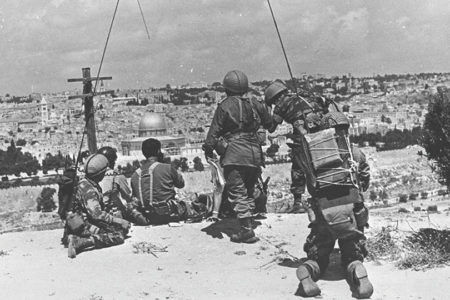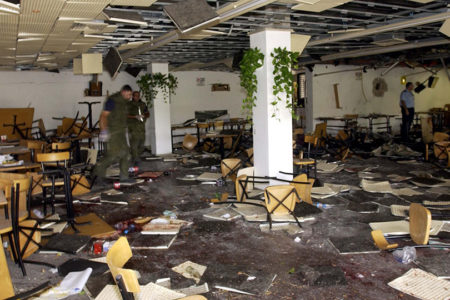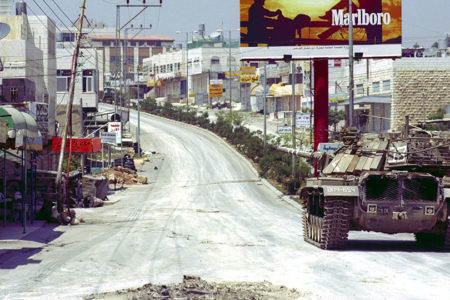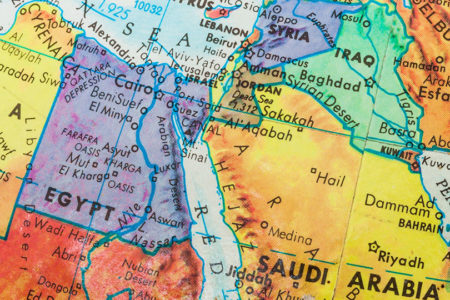The War of Independence
May 1948–May 1949
When the British received their League of Nations mandate over the Holy Land at the San Remo Conference in 1920, they were told to implement the Balfour Declaration that called for “the establishment of a national home for the Jewish people” on an area that encompassed all of Jordan, including Judea and Samaria (West Bank); the Gaza Strip; and the Golan Heights.
A year later, the British gave 77 percent of that territory to the Arabs, establishing Transjordan (now Jordan) and installing Saudi Arabian Emir Abdullah as its head. Jews were expelled and no Jewish immigration was permitted there. In 1923 Britain gave the Golan Heights to the French, who ruled Syria.
Despite the creation of Jordan, extremely bloody Arab riots broke out in Palestine between 1920 and 1929. Between 1936 and 1939, Arab uprisings known as the Arab Revolt occurred. From the 1920s through the 1940s, the Arabs rioted, attacked Jewish settlements, and randomly murdered scores of Palestinian Jews.
On November 29, 1947, the UN passed Resolution 181, partitioning the remaining 23 percent of the land into two states—another one for the Arabs and one for the Jews. Despite the fact that the Jewish allocation (1) now represented only 13 percent of the territory designated in the Balfour Declaration; (2) did not include Jerusalem which was to be international, or Judea and Samaria; and (3) was structured in a way that was almost impossible to defend, the Jewish people accepted the plan anyway and expressed their desire to live in peace with their Arab neighbors. The Arabs, however, did not feel the same way. Although the plan meant that 87 percent of British Mandate Palestine would be in their hands, the Arabs intensified their opposition and made their intentions clear: They not only rejected the UN plan but attacked and murdered scores of Jewish settlers throughout Palestine in what would become a precursor to all-out war in an effort to destroy Israel—and to take it all. On April 13, 1948, they attacked a Jewish medical convoy en route to Hadassah Hospital on Mount Scopus, killing 77 doctors, nurses, and medical personnel. British troops stationed nearby made no attempt to help the convoy.
On May 15, 1948, one day after the new nation of Israel was born, five Arab nations attacked. Their objective: to destroy Israel and drive the Jewish people into the sea. The nations—Jordan, Syria, Iraq, Egypt (Egyptian planes bombed Tel Aviv), and Lebanon— outnumbered Israel by 40 to 1 in population, 100 to 1 in soldiers, and 1,000 to 1 in equipment.
The war ended in the spring of 1949 with four UN-arranged cease-fire agreements between Israel and (1) Egypt, (2) Lebanon, (3) Jordan, and (4) Syria. However, the Arabs refused to make peace.
The Outcome. Israel gained 2,500 more square miles than allotted in the UN partition but lost the Jewish Quarter of the Old City of Jerusalem. Egypt took control of the Gaza Strip, and Jordan annexed the West Bank (Judea and Samaria).
Six thousand Israelis were killed (nearly one percent of the Jewish population of 650,000); and Israel’s military cost reached nearly $500 million.
The Arabs refused to sign a peace agreement with Israel. Azzam Pasha, first secretary general of the Arab League, stated why:
We have a secret weapon which we can use better than guns and machine guns, and this is time. As long as we do not make peace with the Zionists, the war is not over; and as long as the war is not over there is neither victor nor vanquished. As soon as we recognize the existence of the state of Israel, we admit by this act that we are vanquished.






